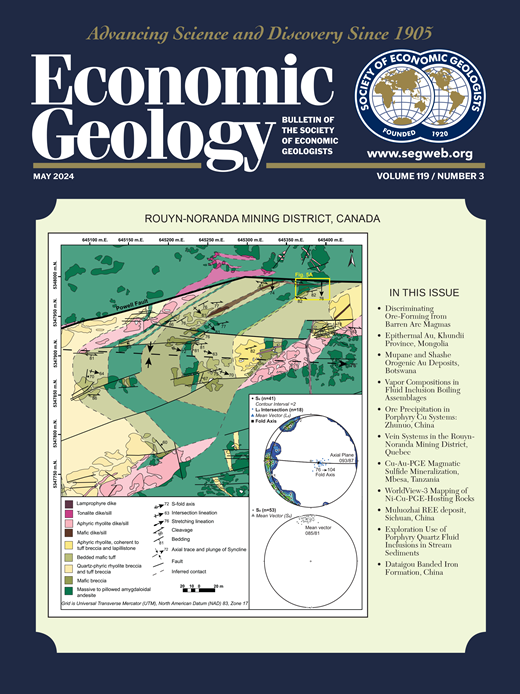巴西东部伟晶岩省的锂:一个突出富锂辉石矿床的合成
IF 4.9
1区 地球科学
Q1 GEOCHEMISTRY & GEOPHYSICS
引用次数: 0
摘要
巴西东部伟晶岩省占地15万平方公里,是世界上稀有元素伟晶岩最多的地区之一。该省是埃迪卡拉-寒武纪Araçuaí造山带变质-岩浆作用的结果,该作用产生了大量不同类型的花岗岩和无数的伟晶岩。巴西东部伟晶岩省的12个伟晶岩区中,含锂辉石的伟晶岩区只有3个,含锂辉石的富锂辉石矿床只有1个,锂矿储量可达数千万吨,这就是Araçuaí区,巴西生产的锂矿和最近发现的所有富锂辉石矿床都集中在这里,锂矿资源量超过5亿吨。这个世界级的锂区包括不同的含锂辉石矿床,为找矿目的命名为富锂辉石伟晶岩(SRP)、锂辉石-辉石伟晶岩(SPP)、锂辉石-透辉石伟晶岩(PSP)、透辉石-电气石伟晶岩(PTP)和钠辉石-电气石伟晶岩(ATP)。所有这些伟晶岩都是在区域构造变质事件之后发现的,它们与由二云母、白云母-钠长石和伟晶岩样浅花岗组成的侵入岩(1-5公里)接近。含堇青石-黑云母(±红柱石)片岩的低压/高温变质沉积层序为SRP、SPP和PSP矿床。它们含锂辉石,浸染在无分带至分带差的伟晶岩中,这些伟晶岩形成脉群或大单体,或在富含锂辉石的简单分带伟晶岩单元中。锂辉石中PTP和ATP矿床相对较少,主要分布在复杂带状伟晶岩的内部带、石英芯和/或富钠长岩单元中。现场绘图、土壤地球化学、挖沟和密集钻探在短短2年内发现了Bandeira大型锂辉石矿床,这是一个非常成功的、知识驱动的勘探工作的例子。本文章由计算机程序翻译,如有差异,请以英文原文为准。
Lithium in the Eastern Brazilian Pegmatite Province: A Synthesis Highlighting Spodumene-Rich Deposits
Covering 150,000 km2, the Eastern Brazilian pegmatite province stands out as one of the largest populations of rare element pegmatites in the world. The province is a result of metamorphic-magmatic processes that produced enormous volumes of distinct granite types and countless pegmatites in the Ediacaran-Cambrian Araçuaí orogen. Among the 12 pegmatite districts of the Eastern Brazilian pegmatite province, only three contain spodumene-bearing pegmatites, and only one contains spodumene-rich deposits that may reach tens of million tons of lithium ore. This is the Araçuaí district, which accounts for most of the lithium ore produced in Brazil and all recent discoveries of spodumene-rich deposits, reaching over half a billion tons of lithium ore resources. This world-class lithium district comprises distinct spodumene-bearing deposits named, for prospecting purposes, spodumene-rich pegmatites (SRP), spodumene-petalite pegmatites (SPP), spodumene-perthite pegmatites (PSP), perthite-tourmaline pegmatites (PTP), and albite-tourmaline pegmatites (ATP). All these pegmatites postdate the regional tectono-metamorphic events and are found close (1–5 km) to intrusions comprising two-mica, muscovite-albite, and pegmatoid leucogranites. Low-pressure/high-temperature metasedimentary successions with cordierite-biotite (± andalusite) schists host the SRP, SPP, and PSP deposits. They contain spodumene disseminated in unzoned to poorly zoned pegmatites that form dike swarms or large single bodies or in spodumene-rich units of simple zoned pegmatites. The PTP and ATP deposits are relatively poor in spodumene, which is found in internal zones, quartz cores, and/or albite-rich units of complex zoned pegmatites. Field mapping, soil geochemistry, trenching, and intensive drilling revealed the large Bandeira spodumene deposit in just 2 years, which is described here as an example of highly successful, knowledgedriven exploration work.
求助全文
通过发布文献求助,成功后即可免费获取论文全文。
去求助
来源期刊

Economic Geology
地学-地球化学与地球物理
CiteScore
10.00
自引率
6.90%
发文量
120
审稿时长
6 months
期刊介绍:
The journal, now published semi-quarterly, was first published in 1905 by the Economic Geology Publishing Company (PUBCO), a not-for-profit company established for the purpose of publishing a periodical devoted to economic geology. On the founding of SEG in 1920, a cooperative arrangement between PUBCO and SEG made the journal the official organ of the Society, and PUBCO agreed to carry the Society''s name on the front cover under the heading "Bulletin of the Society of Economic Geologists". PUBCO and SEG continued to operate as cooperating but separate entities until 2001, when the Board of Directors of PUBCO and the Council of SEG, by unanimous consent, approved a formal agreement of merger. The former activities of the PUBCO Board of Directors are now carried out by a Publications Board, a new self-governing unit within SEG.
 求助内容:
求助内容: 应助结果提醒方式:
应助结果提醒方式:


